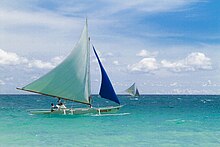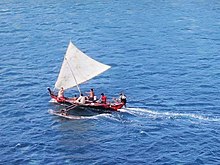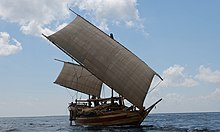
A pump boat is an outrigger canoe native to Southeast Asia powered by a small gasoline or diesel engine. Smaller pump boats might be powered by the sort of small single-cylinder engine used to drive a water pump. Larger ones are often powered by recycled automobile engines.

Okir, also spelled okil or ukkil, is the term for rectilinear and curvilinear plant-based designs and folk motifs that can be usually found among the Moro and Lumad people of the Southern Philippines, as well as parts of Sabah. It is particularly associated with the artwork of the Maranao and Sama (Badjao) tribes, although it can also be found to a lesser extent among the Maguindanao, Iranun, Tausug, Yakan, and Lumad groups. The design elements vary among these ethnic groups, with the greatest refinement being found among the Maranao.

Semporna is the capital of the Semporna District in the Tawau Division of Sabah, Malaysia. Its population was estimated to be around 35,301 in 2010.

The Sama-Bajau include several Austronesian ethnic groups of Maritime Southeast Asia. The name collectively refers to related people who usually call themselves the Sama or Samah ; or are known by the exonym Bajau. They usually live a seaborne lifestyle and use small wooden sailing vessels such as the perahu, djenging (balutu), lepa, and vinta (pilang). They also use medium-sized vessels like the jungkung, timbawan and small fishing vessels like biduk and bogo-katik. Some Sama-Bajau groups native to Sabah are also known for their traditional horse culture.

Banguingui is a distinct ethnolinguistic group native to Balanguingui Island but also dispersed throughout the Sulu Archipelago and southern and western coastal regions of the Zamboanga Peninsula in Mindanao, Philippines.

The vinta is a traditional outrigger boat from the Philippine island of Mindanao. The boats are made by Sama-Bajau, Tausug and Yakan peoples living in the Sulu Archipelago, Zamboanga peninsula, and southern Mindanao. Vinta are characterized by their colorful rectangular lug sails (bukay) and bifurcated prows and sterns, which resemble the gaping mouth of a crocodile. Vinta are used as fishing vessels, cargo ships, and houseboats. Smaller undecorated versions of the vinta used for fishing and transportation are known as tondaan and bogo-lamak.
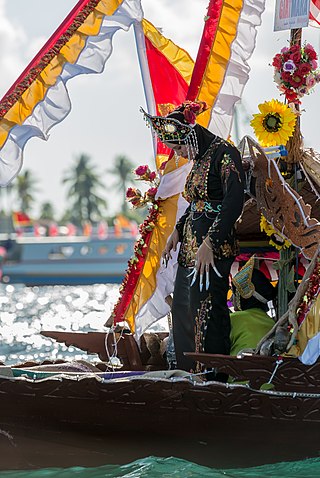
Pangalay is the traditional "fingernail" dance of the Tausūg people of the Sulu Archipelago and eastern coast Bajau of Sabah.

The Sama–Bajaw languages are a well-established group of languages spoken by the Sama-Bajau peoples of the Philippines, Indonesia, and Malaysia.
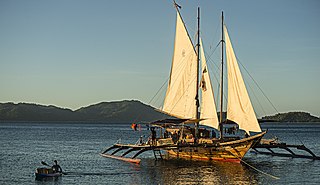
A balangay, or barangay, is a type of lashed-lug boat built by joining planks edge-to-edge using pins, dowels, and fiber lashings. They are found throughout the Philippines and were used largely as trading ships up until the colonial era. The oldest known balangay are the eleven Butuan boats, which have been carbon-dated individually from 689 to 988 CE and were recovered from several sites in Butuan, Agusan del Norte. The Butuan boats are the single largest concentration of lashed-lug boat remains of the Austronesian boatbuilding traditions. They are found in association with large amounts of trade goods from East Asia, Southeast Asia, and as far as Persia, indicating they traded as far as the Middle East.

Buggoh is a type of small dugout canoe of the Sama-Bajau people of the Philippines. They are made from a single log hollowed into a canoe with a rounded bottom. It is equal-ended, with the prow and the stern dropping straight down or sloping outward. They are sometimes equipped with two outrigger floats. They are usually around 1.5 to 4.5 m long. It is also known by various other names, including boggo', buggoh jungalan, buggoh-buggoh, or beggong.

Bangka are various native watercraft of the Philippines. It originally referred to small double-outrigger dugout canoes used in rivers and shallow coastal waters, but since the 18th century, it has expanded to include larger lashed-lug ships, with or without outriggers. Though the term used is the same throughout the Philippines, "bangka" can refer to a very diverse range of boats specific to different regions. Bangka was also spelled as banca, panca, or panga in Spanish. It is also known archaically as sakayan.
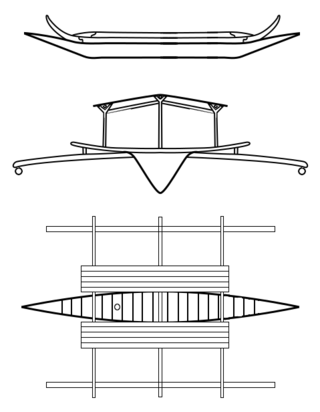
Djenging is a type of large double-outrigger plank boat built by the Sama-Bajau people of the Philippines. It is typically used as a houseboat, though it can be converted to a sailing ship. It was the original type of houseboat used by the Sama-Bajau before it was largely replaced by the lepa after World War II. Larger versions of djenging were also known as balutu or kubu, often elaborately carved with bifurcated extensions on the prow and stern.

Birau, is a type of small dugout canoe of the Sama-Bajau people of the Philippines. They are made from a single log hollowed into a canoe with a rounded bottom. The prow and stern of the vessel usually has knob-like protrusions. A smaller wider variant without these knobs is known as bitok. Birau are usually around 1.5 to 4.5 m long. They are sometimes equipped with two outrigger floats. They are very similar to the buggoh, differing only in that the prow and the stern of the birau slope inward.

Junkun, is a type of small dugout canoe of the Sama-Bajau people of the Philippines. They are usually made from a single log, though a single plank can be added to the sides, and longer boats can include ribs that support a deck made of planks. They are around 2.5 to 8 m long. They have knob-like protrusions on the tip of the prow and the stern, which also sweep upwards from the waterline. They are sometimes equipped with double outriggers. They are used for fishing and short-distance travel.
Ontang is a type of raft of the Sama-Bajau people of the Philippines. They resemble a miniature catamaran, with two bamboo floats about 1 m (3.3 ft) long connected by two bow-shaped booms. A platform made split bamboo is built on top of the booms. Ontang can be used for fishing, but they can also hold lanterns during night-time fishing. They are typically towed behind Sama-Bajau houseboats during travel, with the towing line commonly strung with baited fish hooks.
Bangka anak-anak are very small dugout canoes among the Sama-Bajau people of the Philippines. They are typically made by Sama-Bajau fathers for their children and are patterned after the larger Sama-Bajau dugout canoes. They can be used for transportation between the Sama-Bajau houseboats, but are more commonly used for playing. They are typically no longer than around 1.5 m (4.9 ft) long. Children as young as three or four can use these boats, which allows them to learn valuable maritime skills.
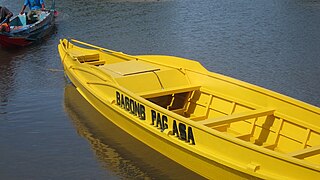
Tiririt, also known as taririt or papet, is a type of small dinghy of the Sama-Bajau and Tausug people of the Philippines. It is commonly motorized. It is usually carried aboard larger motherships and assists in transporting passenger and cargo to the shore, as well as in towing the boat to port. However, it can also be used as a small inter-island transport. It is roughly leaf-shaped in outline with a distinctive hump-backed side-profile. The prow and stern can sometimes rise up into arcs. It normally has no outriggers.
Tempel, also known as temper or kurikong, is a type of wooden motorized boat used by the Yakan, Tausug, and Sama-Bajau people of the Philippines. It is commonly used in the Sulu Archipelago and the Zamboanga Peninsula. It is around 48 ft (15 m) long, 11 ft (3.4 m) deep, and around 5 ft (1.5 m) at the widest point. It has a V-shaped cross-section at the front, though it is flat-bottomed on the stern for stability. It is commonly made from thick marine lauan plywood attached to ribs and caulked with epoxy. Tempel can also be made from fiberglass, though wood is preferred. Tempel are larger than the junkung but smaller than the kumpit. They are usually used as cargo ships.
Junkung, also spelled jungkung or jungkong, is a small wooden sail to motorized boat used by Tausug, Sama-Bajau, and Yakan people of the Philippines. It is a fast cargo ship and is commonly used as a smuggling vessel in the maritime borders of the Philippines, Sabah, Malaysia and Eastern Indonesia. They are also sometimes used by pirates and Abu Sayyaf terrorists in and around the Sulu Sea.
Kulibo, or Kulibu, is a small wooden motorized traditional fishing boat with short double outriggers used by Tausug, Sama-Bajau, and Yakan people of the Philippines. Characterized as "ring-netters," they are classified as "small-scale commercial fishing vessels." This type of boat is commonly used by fisherfolk in Tawi-Tawi to catch small fishes, usually during the night.





















